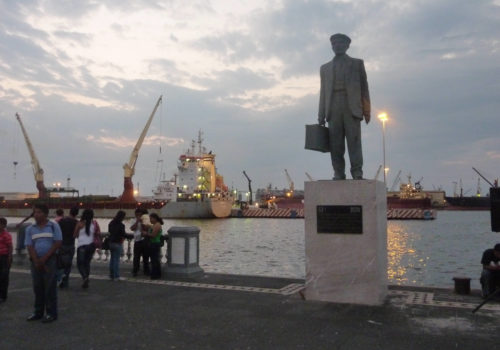Trisha Ziff is a British filmmaker who lives and works in Mexico. Curator in contemporary photography, she just finished a documentary about Capa’s Mexican Suitcase, parallel to the exhibition. Motivated by the desire to expose the truth about Spanish history, she filmed in Europe and America to follow the unbelievable journey taken by these Civil War negatives. Capa, Taro and Chim, who fought fascism through photography, were known Revolutionaries. Trisha Ziff covers the context in which these pictures were taken, traveling the world until arriving in Mexico, who was at the time, the only country open to accepting Spanish refugees. She gave the ICP the opportunity to restore the negatives, and brought the Mexican Suitcases to New York in 2007. Criticized for not having “sufficiently” covered Robert Capa’s documents, Trisha Ziff talks from Mexico City about her feelings and the movie prior to its world premiere in Arles.
Trisha, can you tell us about what the movie deals with and how?
It is a 90-minute feature film. Although it is called The Mexican Suitcase, it covers three stories. The first, how Capa, Taro and Chim’s negatives traveled from Spain to France then to Mexico where they were discovered 70 years later, and to New York, where they were displayed. The movie evidently shows the pictures and negatives in the suitcases. The second is about Republican dissidents living in exile in Mexico after the end of the Spanish Civil War. This section is very important because Mexico was the only country to have opened their borders. We discover interviews of four generations of refugees. That is also why the Spanish Suitcase has this name: it is the memory of these people, symbolic of Mexico’s role at the time. The third is about providing the Spanish people with images of their past. It evokes their right to discover pictures of a major moment in their national history, uncovering pictures of their ancestors 40 years after Franco’s death. I was more interested in evoking the context and the common adventure experienced by the men photographed in these documents than about evoking the three photographers. My documentary shows the parallel between Spanish history, its exiled fighters, and these pictures. It is a very political film, evocative of the steps taken by Magistrate Baltasar Garzon.
How long did it take for you to finish the movie?
I have been working on this project for a long time, but it took only two years to film everything. It was fairly quick.
You show images from around the world?
Yes, like the suitcase, I traveled to Spain, France, Mexico, and the United States.
You found pictures of a most unusual scene…
Yes, I was lucky to have discovered a sequence about the nurse that cared for Gerda Taro before her death. She tells how Gerda had requested her camera on her death bed. It was the only part of the film I didn’t actually make myself.
You discovered the pictures by Capa, Taro, and Chim in Mexico?
Yes, and I took them personally to the ICP in New York.
What does your movie add to the exhibition?
The exhibition covers the negatives and the photographers, but very little about the time period. We don’t learn where the name Mexican Suitcase comes from, for example. Not in the catalog either. I was a bit disappointed despite the great interest and research for the ICP’s installation.
You met Ben Tarver, the man who inherited the Mexican Suitcase, in Mexico?
Obviously, I was the only person to meet him, and I negotiated to convince him to turn the suitcase over to the ICP. The museum forgot about Ben Tarver. In the movie, we see him talk, we see his small home, his timid personality, slightly uncomfortable in front of the movie camera. He tells about his family, how nearly accidentally he became the owner of these pictures through one of his aunts. He also talks about General Aguilar, who took the negatives to Mexico.
After their discovery in 1995, why did Ben Tarver take so long to return the Mexican Suitcase to their rightful owners?
I think the question people should ask is: Why did the ICP take so long to recuperate the negatives? The museum knew in 1995 when they received a letter from Mr. Tarver that they were in his possession. Why did it take them 14 years to acquire them? Why didn’t anyone from the ICP fly to Mexico City to pick them up? Ben Tarver is American and speaks English, and Mexico City is only a 4 ½ hour flight from New York.
Interview by Jonas Cuénin
The Mexican Suitcase
Movie by Trisha Ziff, HD color, 86min.
World Premiere at the Théâtre Antique d’Arles July 5, 2011 at 10:30pm.
















